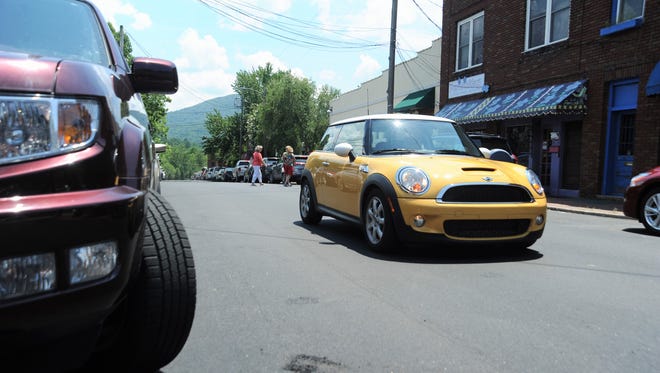Cherry Street to be converted to one-way

Cherry Street, a busy one-block thoroughfare in the heart of Black Mountain’s downtown business district, will undergo a major change in the coming weeks.
A resolution passed by aldermen during the board’s Aug. 12 regular meeting authorizes the conversion of the existing two-way traffic pattern on the road between Sutton Avenue and State Street to a one-way, northbound flow.
The measure was enacted in response to recommendations stemming from a pair of studies examining traffic and circulation along the street.
The first study, completed in August 2018 by Waynesville-based J.M. Teague Engineering, focused solely on Cherry Street and concluded that “a one-way northbound configuration is the best way to manage the ongoing traffic on Cherry Street and U.S. 70 (State Street).” The pattern would allow pedestrians to watch for traffic from one direction before crossing, “making it safer through less pedestrian and vehicle interaction,” the study found.
The J.M. Teague project was conducted after business owners in the district approached aldermen in May 2018 and asked the board to consider converting the street to a one-way flow. The request came after the Buncombe County Metropolitan Sewerage District replaced water lines under Cherry Street. Town officials elected to not restripe the road until a decision could be reached regarding the flow of traffic.
While the study recommended changing the flow of traffic, aldermen decided to delay making a decision pending the results of a comprehensive parking and circulation study. The board approved a $35,000 contract with the Asheville branch of Traffic Planning and Design Inc. on May 13.
The town was awarded $28,000 for the study through a French Broad Metropolitan Planning Organization grant in the spring of 2018. Data collection for the study, which will provide insight into parking and and the flow of traffic in the downtown district, began May 29.
“The first part of the study was to focus on Cherry Street, so we could get that done,” Town Manager Josh Harrold said. “The broader study is still ongoing and I would anticipate it being a few more months until it’s complete.”
The street, which measures 35 feet from curb to curb, now operates as a two-way flow with one 9-foot travel lane in each direction and parallel parking on both sides. TPD collected turning movement counts on a weekday in May, according to the study.
The data showed 45 vehicles used Cherry Street during morning peak hours of 7 - 9 a.m. Twenty of them traveled north and 25 traveled toward Sutton Avenue. Eighty-four motorists — 29 northbound and 55 southbound — used the road during the midday peak hours of noon-2 p.m.
The evening peak hours of 3-6 p.m. saw 19 vehicles travel north, while 42 drove south.
Pedestrian activity along Cherry Street was described as “high” because of shops on each side.
“Because of the narrow width of the roadway, low volume and speed of traffic and pedestrian scale of development along Cherry Street, pedestrians frequently cross mid-block going from one side of the street to the other,” the study explained. Yet “very few” pedestrian-vehicle conflicts were observed during data-collection times.
The majority of conflicts observed occurred at the north and south intersections of the street.
“Pedestrians appear to have the most difficulty crossing Cherry Street in the marked crosswalk at the intersection of State Street,” the results read. “This is because the angle of the intersection creates a long crossing distance and potential conflicts with turning vehicles coming from multiple directions.”
The study also found northbound left-turns onto State Street, which are prohibited, create occasional queue backups. It attributed the occurrences to inadequate signage.
TPD reviewed the J.M. Teague analysis prior to making its recommendation, which included changing the flow of traffic to a one-way northbound direction and continuing to prohibit left-turns from Cherry to State Street with additional standardized signage.
The recommendations also included maintaining the existing parallel parking on both sides of the street, while increasing the standard length of the spaces to 22 feet in length. Two spaces would be lost in the change, while at least two handicap-accessible spaces would be added to each side of the street.
TPD suggested curb extensions at the intersection of Cherry and State Streets.
The bump-outs would assist in discouraging drivers from turning left onto State Street and reduce the distance for pedestrian crossing, Harrold told the board.
The resolution, presented by Harrold and adopted unanimously by the board, cited public safety and received support from the Black Mountain fire and police departments. Maintaining parallel parking on both sides of the street not only reduces the loss of spaces, but allows the width necessary for motorists to get safely around delivery trucks, according to the director of planning and development, Jessica Trotman.
The town will implement the change before the fall, according to Harrold.
“I hope to have it done by the end of September,” he said. “We are working on lining up someone to restripe the road and looking at quotes to do the curb extensions on the north end of Cherry Street.”
Once the full TPD study is completed, the town will have a better understanding of how to address parking and transportation downtown, Harrold said.
“We’ll present it and I would anticipate there being suggestions that will help us downtown,” he said. “I don’t know what those will be yet, but this study will give us some good information.”